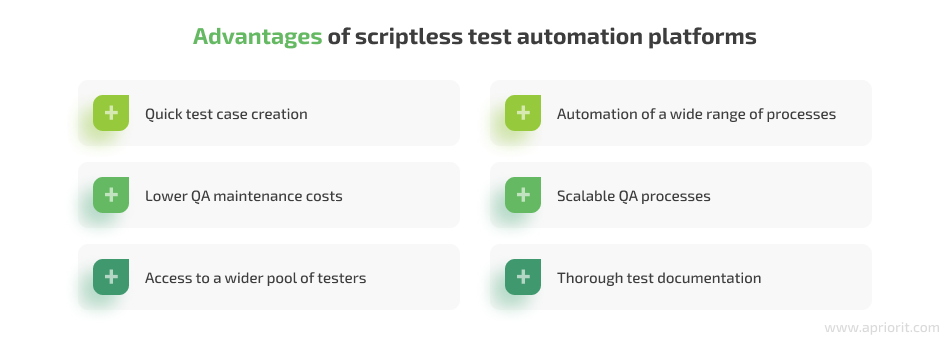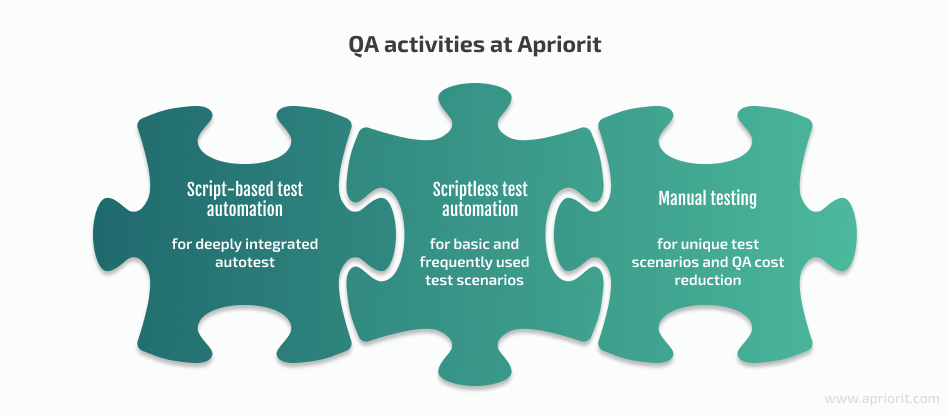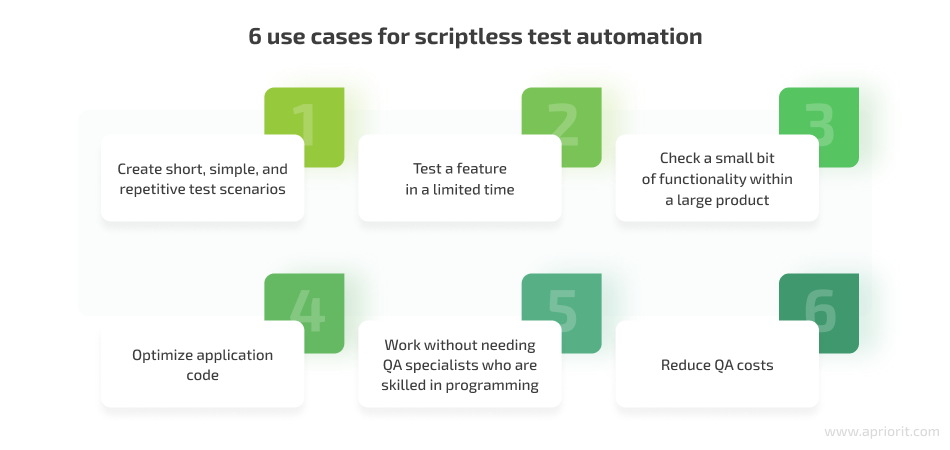Scriptless test automation sounds like a revolutionary approach that will completely supplant traditional script-based testing. It promises quick and simple creation of test cases, reduced quality assurance (QA) costs, and easy-to-understand QA procedures that don’t require professional training.
But can you apply scriptless test automation to any QA activity? Or is it best to create scriptless tests only for certain use cases? In this article, we examine how scriptless test automation works, when to use it, and how to improve your testing strategy with it. This article will be useful for QA engineers and team leaders who want to optimize their testing activities.
What is scriptless test automation?
There’s an ongoing trend in software development of making things simpler and more automated. Scriptless platforms are part of this trend. Such platforms provide users with graphical interfaces and convenient tools to develop and automate test scenarios without coding. This way, people with limited to no programming skills can participate in quality assurance activities.
Here’s how a scriptless platform usually works:
- The user designs a test scenario and passes it by manually going through the scenario.
- The platform records this user activity and turns it into test code.
- When a user runs the test, the platform repeats previously recorded actions.
- If the system behaves as expected, the platform marks the test as passed.
- If the system’s behavior differs from the recorded scenario and returns a different result, the test fails.
- The user reviews the failed scenario, describes the bug, and creates a ticket for it.
The most well-known scriptless test automation tools based on such a recording and playback workflow are Katalon Studio, Selenium IDE, Cloud QA, Leapwork, and Perfecto.
Read also
How to Build a Custom CRM Solution: Benefits, Types, and Development Considerations
Build a CRM that fits your business. Learn the key steps, challenges, and best practices for developing a custom CRM that enhances efficiency and growth.

There are two key types of scriptless automation:
- No-code systems that allow users to develop test cases without writing a single line of code, instead using interactive graphical user interfaces (GUIs)
- Low-code platforms that provide GUIs with the option to add custom scripts to test cases
| No-code | Low-code | |
|---|---|---|
| Users | Business users QA specialists | QA specialists |
| Required coding skills | None | Low |
| Use cases | Automating generic testing processes Writing typical test cases | Automating generic testing processes Writing typical test cases Writing customized test cases |
| Test flexibility | Yes | Yes |
| Customization options | Limited | Fully customizable |
Originally, low-code and no-code test automation were created to test web applications that required lots of similar tests to confirm their usability across various browsers, screens, and devices. But nowadays, they are also used to develop mobile applications, customer relationship management systems, project management platforms, etc.
Scriptless platforms help organizations increase testing speed and employ a wider pool of users in QA. For example, any employee of an organization can create a test on a no-code platform and turn it into an automated test case. This saves time for QA specialists, software development engineers in test (SDETs), and automation engineers to focus on more challenging tasks.
Because of their simplicity, scriptless testing tools are great for smoke tests, in-sprint automation, and certain regression testing activities. But they can’t cover all the QA needs during product development. That’s why there’s no either-or choice between scriptless and script-based test automation. Later, we show how we combine scriptless and traditional testing at Apriorit to achieve optimal results in our QA activities.
Now that we know what scriptless test automation is, let’s take a closer look at the pros and cons of using this method.
What are the pros and cons of scriptless testing?
Scriptless test automation platforms help organizations improve their QA processes by providing:

Quick test case creation. Thanks to a simple GUI and easy-to-use functionalities, scriptless platforms allow users with no programming experience to quickly configure simple tests. This saves QA specialists hours of manual programming and allows users to learn about QA processes themselves.
Automation of a wide range of processes. Though limited in their abilities, scriptless test platforms can be used as complex solutions to automate many processes throughout the software development life cycle (SDLC). Adopting scriptless test automation frameworks is generally easier for organizations than using traditional QA, as the latter require a specific set of skills to automate each process.
Lower QA maintenance costs. Creating and maintaining tests is faster and easier with scriptless testing tools. It can be done by any business user without specific development and testing knowledge. QA specialists only have to write test modules once, and other users can reuse them when needed.
Scalable QA processes. Scriptless platforms allow users to combine, change, and reuse parts of test scenarios. When a user changes the back end of a test scenario, the platform automatically updates all test cases with the changed module. This allows for quick and painless scaling of test cases.
Access to a wide pool of testers. The need to master a certain testing tool, framework, or integration may become a bottleneck for a project. In scriptless testing, a user doesn’t need to know the inner workings of a test case, since they work only with the GUI of the testing platform. In this way, scriptless testing eliminates the need to have a QA team member with knowledge of a specific tech stack and allows almost anyone to join the QA team.
Thorough test documentation. Detailed descriptions of test modules, records of test cases, and logs of user activity provide everyone with details on the testing process. Scriptless platforms also record who changed what in the QA environment.
Read also:
6 Ways to Improve Software Testing
The advantages of scriptless testing make it a rather attractive choice for IT organizations that are looking for ways to improve their QA routine. However, it has some severe limitations that organizations have to take into account:

Few to no customization options. Scriptless no-code test automation tools have only a set toolbox for test creation. Low-code platforms provide some flexibility, since they allow users to add their custom code to tests. But they still limit options in creating test scenarios. Without customizable test modules, users can’t adjust scenarios to their needs and create unique test cases. Because of that, it’s best to use scriptless tests only for testing the parts of your system that will not change.
Need for coding skills to solve non-trivial tasks. Although scriptless platforms help you create and structure test scenarios automatically, there always will be some scenarios that require manually coded tests. For organizations that use scriptless tests, this means they still need QA specialists with coding skills to ensure the quality of their system.
Limited compatibility. Each codeless test automation platform has limitations in its compatibility with certain browsers, devices, and software. To build a universal testing system, an organization has to combine several scriptless platforms or combine them with manual testing activities.
Risk of errors in automated tests. Although automated tests in scriptless platforms are generated by a computer using predefined modules, there still may be errors. Errors in code generation can lead to incorrect or faulty test scenarios and, ultimately, to wrong test results. To fix such errors, QA specialists have to spend many hours manually reviewing and rewriting test modules.
Vendor lock-in. Code generated by a specific scriptless testing platform is often unique to the platform or operating system. This property of such platforms makes organizations dependent on the platform they choose. If an organization decides to change their test automation tool or introduce a new framework in the middle of the project, QA engineers have to completely rewrite existing test cases.
Even with such severe limitations, scriptless testing tools have become popular within QA teams. Let’s see how such tools fit into a comprehensive testing strategy.
How to enhance your QA strategy with scriptless testing
Adopting a scriptless approach to testing as the only quality assurance method is risky because it doesn’t provide users with tools to create complex and unusual test scenarios. Thus, users can’t fully test their system and may overlook critical quality issues.
That’s why it’s best to use scriptless testing in combination with other QA approaches. At Apriorit, we combine manual, script-based, and scriptless testing to create a fitting testing strategy for each of our projects. This combination allows us to be flexible with QA activities and find the perfect balance between testing speed, scalability, coverage, and final product quality.
Here’s how we distribute QA activities between various types of testing at Apriorit:

- Script-based test automation is great for autotests that require deep and precise integration into a project. We also use it to create test scenarios that are too complex for scriptless platforms.
- Scriptless test automation helps us to quickly create autotests for GUI elements of our products. We use no-code/low-code tools including Katalon Studio, Leapwork, Selenium, and Nunit to develop and automate simple test scenarios that we’ll need to run lots of times.
- Manual testing is reserved for several cases:
- A test case is faster to write manually than to design with dedicated tools
- We only need to use the test a couple of times
- Buying a license for a dedicated testing tool is more expensive than writing a test case manually
- Test automation tools don’t cover the scenario we need to test
As you can see, techniques for scriptless testing have several use cases where they outshine traditional automated and manual approaches. Let’s take a closer look at them.
When to use scriptless test automation
Scriptless testing platforms shine best when you need to:

- Create short, simple, and repetitive test scenarios. Scriptless testing platforms provide users with everything required to frequently test the basic features of a system. In terms of simple tests, such platforms provide the same results as manual testing and script-based automation approaches. But going with scriptless testing tools also allows you to reduce the cost of QA activities thanks to fast test creation and accessibility to users without programming skills.
- Test a feature in a limited time. If you don’t have enough time to test a feature before the product release or the end of the sprint, creating a test with a scriptless tool will allow you to check that the feature works as intended and avoid overtime. You can then make plans for its improvement that you can add to the next sprint or release.
- Check a small bit of functionality within a large product. If development of new functionality doesn’t require changes in the core of the product, you can cover new code with scriptless autotests and integrate them into an already existing testing strategy.
- Optimize the application’s code. During code optimization, the product usually changes only from the inside. Its GUI and UI usually stay the same. Covering optimized code with script-based tests means that each time the code is changed, QA specialists need to adjust the scripts accordingly. Scriptless tests focus on GUI elements and thus don’t depend on the underlying code.
- Work without needing QA specialists skilled in programming. QA specialists who are skilled at programming are quite rare within QA teams, and they often work on several IT projects simultaneously. Going with scriptless test automation allows you to avoid hiring a manual QA engineer or spare the time of the engineers you already have with little influence on the quality of testing activities.
- Reduce QA costs. When facing the need to cut project costs, some project leaders choose to reduce the number of QA activities and focus on software development. Scriptless QA operations cost less than traditional and manual testing, since they’re faster and can be done by a user with few to no programming skills. With scriptless testing, you can stay within the project budget and test the quality of your product.
With scriptless test automation, you can save your QA team’s time on basic tests and focus on your product’s performance, scalability, and security.
Conclusion
While scriptless testing can’t cover all your QA needs, it certainly can speed up and simplify basic QA processes. It’s a great option for testing the product’s GUI, conducting smoke tests, and automating test scenarios that your team will use frequently. By using this approach together with other top-notch practices like test automation results analysis, you can save time and still deliver quality results.
At Apriorit, our QA engineers combine scriptless, script-based, and manual testing to create an optimal testing strategy for each project. We strive to achieve the perfect balance between in-depth checks and speed of testing to help you deliver a quality product within the estimated timeline and budget.
Let’s start discussing which testing strategy will suit your project best!


